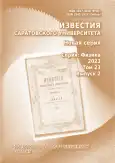Simulation of scattering properties of modular metasurfaces in the 16–25 GHz range and comparison with experimental results
- Authors: Mazinov A.S.1, Padalinsky M.M.1, Boldyrev N.A.1, Starosek A.V.1
-
Affiliations:
- V. I. Vernadsky Crimean Federal University, Physical-Technical Institute
- Issue: Vol 23, No 2 (2023)
- Pages: 102-111
- Section: Articles
- URL: https://journals.rcsi.science/1817-3020/article/view/251101
- DOI: https://doi.org/10.18500/1817-3020-2023-23-2-102-111
- EDN: https://elibrary.ru/SXWPVG
- ID: 251101
Cite item
Full Text
Abstract
About the authors
Alim Seit-Ametovitch Mazinov
V. I. Vernadsky Crimean Federal University, Physical-Technical Institute4 Prospekt Vernadskogo, Simferopol 295007, Republic of Crimea, Russia
Mikhail M. Padalinsky
V. I. Vernadsky Crimean Federal University, Physical-Technical Institute4 Prospekt Vernadskogo, Simferopol 295007, Republic of Crimea, Russia
Nikolay A. Boldyrev
V. I. Vernadsky Crimean Federal University, Physical-Technical Institute4 Prospekt Vernadskogo, Simferopol 295007, Republic of Crimea, Russia
Aleksandr Viktorovitch Starosek
V. I. Vernadsky Crimean Federal University, Physical-Technical Institute4 Prospekt Vernadskogo, Simferopol 295007, Republic of Crimea, Russia
References
- Chen H.-T., Padilla W. J., Zide J. M. O., Gossard A. C., Taylor A. J., Averitt R. D. Active terahertz metamaterial devices // Nature. 2006. Vol. 444, № 7119. P. 597–600. https://doi.org/10.1038/nature05343
- Della Giovampaola C., Engheta N. Digital metamaterials // Nature Materials. 2014. Vol. 13, № 12. P. 1115–1121. https://doi.org/10.1038/nmat4082
- Zaki B., Firouzeh Z.-H., Zeidaabadi-Nezhad A., Maddahali M. Wideband RCS reduction using three different implementations of AMC structures // IET Microwaves, Antennas & Propagation. 2019. Vol. 13, № 5. P. 533–540. https://doi.org/10.1049/iet-map.2018.5024
- Yan X., Liang L., Yang J., Liu W., Ding X., Xu D., Zhang Y., Cui T., Yao J. Broadband, wide-angle, low-scattering terahertz wave by a flexible 2-bit coding metasurface // Optics Express. 2015. Vol. 23, № 22. P. 29128–29137. https://doi.org/10.1364/OE.23.029128
- Khan T. A., Li J., Chen J., Raza M. U., Zhang A. Design of a Low Scattering Metasurface for Stealth Applications // Materials. 2019. Vol. 12, № 18. Article number 3031. https://doi.org/10.3390/ma12183031
- Shao L., Premaratne M., Zhu W. Dual-Functional Coding Metasurfaces Made of Anisotropic All-Dielectric Resonators // IEEE Access. 2019. Vol. 7. P. 45716–45722. https://doi.org/10.1109/ACCESS.2019.2908830
- Zhao Y., Cao X., Gao J., Liu X., Li S. Jigsaw puzzle metasurface for multiple functions: polarization conversion, anomalous reflection and diffusion // Optics Express. 2016. Vol. 24, № 10. P. 11208–11217. https://doi.org/10.1364/OE.24.011208
- Zhuang Y., Wang G., Zhang Q., Zhou C. Low-Scattering Tri-Band Metasurface Using Combination of Diffusion, Absorption and Cancellation // IEEE Access. 2018. Vol. 6. P. 17306–17312. https://doi.org/10.1109/ACCESS.2018.2810262
- Cui T. J., Qi M. Q., Wan X., Zhao J., Cheng Q. Coding metamaterials, digital metamaterials and programmable metamaterials // Light: Science & Applications. 2014. Vol. 3, № 10. P. e218. https://doi.org/10.1038/lsa.2014.99
- Семенихин А. И., Семенихина Д. В., Юханов Ю. В., Благовисный П. В. блочный принцип построения и оценки снижения эпр непоглощающих широкополосных 2-битных анизотропных цифровых метапокрытий // Журнал радиоэлектроники. 2020, № 12. https://doi.org/10.30898/1684-1719.2020.12.4
- Курушин А. А., Пластиков А. Н. Проектирование СВЧ устройств в среде CST Microwave Studio. М. : Издательство МЭИ, 2011. 155 с.
- Благовисный П. В., Семенихин А. И. Полноволновые и импедансные модели сверхширокополосных тонких твистметаполяризаторов для радиомаскирующих покрытий // Журнал радиоэлектроники. 2020. № 8. https://doi.org/10.30898/1684-1719.2020.8.12
- Банков С. Е., Курушин А. А. Электродинамика для пользователей САПР СВЧ. М. : Солон-Пресс, 2017. 316 с.
- Курушин А. А. Школа проектирования СВЧ устройств в CST STUDIO SUITE. М. : One-Book, 2014. 433 с.
- Kane Yee. Numerical solution of initial boundary value problems involving maxwell’s equations in isotropic media // IEEE Transactions on Antennas and Propagation. 1966. Vol. 14, № 3. P. 302–307. https://doi.org/10.1109/TAP.1966.1138693
- Krietenstein B., Schuhmann R., Weiland T., Thoma P. The Perfect Boundary Approximation Technique Facing the Big Challenge of High Precision Field Computation // Proceedings of the XIX International Linear Accelerator Conference (LINAC 98). Chicago, 1998. P. 860–862.
- Weiland T. A discretization model for the solution of Maxwell’s equations for six-component fields // Archiv Elektronik und Uebertragungstechnik. 1977. Bd. 31. S. 116–120.
- Горбачев А. П., Ермаков Е. А. Проектирование печатных фазированных антенных решеток в САПР «CST Microwave Studio». Новосибирск : Изд-во НГТУ, 2008. 88 с.
- Demming-Janssen F., Krüger H., Thoma P., Löcker C., Bertuch T., Eibert T. Time domain simulation of conformal antennas using the finite integration technique (FIT) with PBA geometry discretisation and local time step adaptive sub-gridding // 3rd European Workshop on Conformal Antennas. Bonn, 2003. P. 45–48.
- Мазинов А. С., Фитаев И. Ш., Болдырев Н. А. Влияние пространственной ориентации проводящих элементов составной метаповерхности на их частотные характеристики и диаграммы рассеивания в свч-диапазоне // Вестник Воронежского государственного технического университета. 2022. Т. 18, № 4. С. 86–90.
Supplementary files









